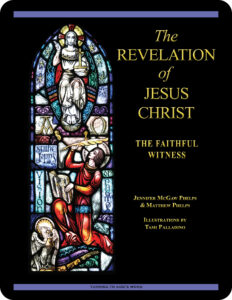 The Revelation of Jesus Christ:
The Revelation of Jesus Christ:
The Faithful Witness
Lesson 22 I Saw a New Heaven & a New Earth
the book of Revelation 21:1–27
Revised Standard Version Catholic Edition (RSVCE)*
New American Bible Revised Edition (NABRE)*
Catechism of the Catholic Church
ex libris (in our library)
glossary for the book of Revelation
cross references in the book of Revelation
chapter-by-chapter review page
next lesson: And Behold, I Am Coming Soon
This material coordinates with Lesson 22 on pages 134–139 in The Revelation of Jesus Christ: The Faithful Witness.
“Great and wonderful are your deeds, O Lord God the Almighty! Just and true are your ways,
O King of the ages! Who shall not fear and glorify your name, O Lord? For you alone are holy.
All nations shall come and worship you, for your judgments have been revealed.”
—the book of Revelation 15:3–4
welcome to our in-depth study of the book of Revelation
We invite groups and individuals to check out the sample first lesson and video from this 23-lesson Turning to God’s Word Catholic Bible study. Our online pages link
link  to the free lesson videos, a glossary, cross references in the biblical text, and a chapter-by-chapter review page—and they also include illustrations, maps, additional commentary, and prayers based on the primary Scripture in each lesson. The Revelation of Jesus Christ: The Faithful Witness has been granted an imprimatur. The study may be purchased from our website shop. If you have a Bible-related question or comment, click on the “ask us your question” or “what do you think” button on any study page.
to the free lesson videos, a glossary, cross references in the biblical text, and a chapter-by-chapter review page—and they also include illustrations, maps, additional commentary, and prayers based on the primary Scripture in each lesson. The Revelation of Jesus Christ: The Faithful Witness has been granted an imprimatur. The study may be purchased from our website shop. If you have a Bible-related question or comment, click on the “ask us your question” or “what do you think” button on any study page.
open with prayer
It’s always wise to begin any Bible study with prayer, whether reading the Scriptures alone or meeting with others in a discussion study group. You can pray using your own words or use one of the opening prayers on our website. We especially like the following:
Lord Jesus, you promised to send your Holy Spirit
to teach us all things.
As we read and study your word today,
allow it to touch our hearts and change our lives. Amen.
let’s review—the book of Revelation 20:1–15
In Lesson 21 This Is the First Resurrection, the key points are connected to the angel that appears from heaven with the key to the bottomless pit and a great chain. He seizes the dragon and seals him in the pit for a thousand years, after which the dragon must be let out for a little while. Thrones of judgment appear for those who were beheaded for their testimony to Jesus. They come to life and reign with Christ a thousand years, after which the remaining dead come to life. This is the first resurrection, over whom second death has no power. After the thousand years are ended, Satan will be released to deceive the nations for a short time, but he immediately will be permanently defeated and thrown into the lake of fire and brimstone with the beast and the false prophet. God appears on his throne, and the earth and sky flee from his presence. The dead are judged by what they had done when alive. After judgment is finished, Death and Hades are thrown into the lake of fire, which is the second death.
the wedding has taken place—introducing Mr. & Mrs. Lamb
In the twenty-first chapter in the book of Revelation we finally meet the Bride of the Lamb. The long-awaited marriage of humanity and divinity has occurred. The bride is resplendently adorned with 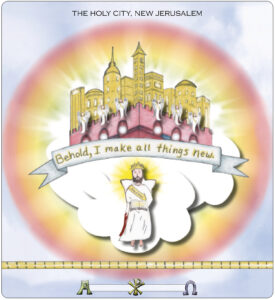 jewels, and everything about the holy city of Jerusalem is new. One of the more interesting insights to come out of this
jewels, and everything about the holy city of Jerusalem is new. One of the more interesting insights to come out of this 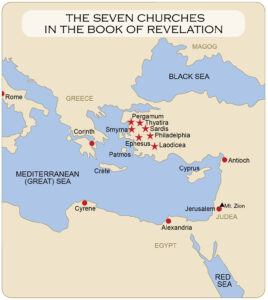 lesson is the strong similarity in tone between the book of Revelation 21:5–8 and the letters to the seven churches found in the second and third chapters in the book of Revelation. Much of the language in this section has a familiar ring, and to top it off, John specifically is instructed to write down what he’s being told. This suggests yet another letter—an eighth—written to the universal Church still awaiting Final Judgment, and the book of Revelation can be understood in this light. Click on the image (above right) to enlarge Turning to God’s Word co-founder Tami Palladino’s illustration, which is on page 136 of The Revelation of Jesus Christ: The Faithful Witness. The map locating the seven churches that receive dictated letters from Jesus appears on page 138 and elsewhere in the study book; the image of the map The Revelation of Jesus Christ: The Faithful Witness and can be enlarged by clicking on it.
lesson is the strong similarity in tone between the book of Revelation 21:5–8 and the letters to the seven churches found in the second and third chapters in the book of Revelation. Much of the language in this section has a familiar ring, and to top it off, John specifically is instructed to write down what he’s being told. This suggests yet another letter—an eighth—written to the universal Church still awaiting Final Judgment, and the book of Revelation can be understood in this light. Click on the image (above right) to enlarge Turning to God’s Word co-founder Tami Palladino’s illustration, which is on page 136 of The Revelation of Jesus Christ: The Faithful Witness. The map locating the seven churches that receive dictated letters from Jesus appears on page 138 and elsewhere in the study book; the image of the map The Revelation of Jesus Christ: The Faithful Witness and can be enlarged by clicking on it.
 why the world is the way it is (01:09:39)
why the world is the way it is (01:09:39)
The twenty-first chapter in the book of Revelation continues to look at the  end of time. The book of Revelation 21:5 offers a key to what’s happening when the one sitting on the throne announces: “Behold, I make all things new.” In the video for this lesson, Turning to God’s Word author Matthew Phelps addresses the idea that if God loved us he would have made the world good. It’s not about God creating the world because he loves us, it’s about creating the world so that we can love God. For God, the possibility of love is worth all of the evil in the world.
end of time. The book of Revelation 21:5 offers a key to what’s happening when the one sitting on the throne announces: “Behold, I make all things new.” In the video for this lesson, Turning to God’s Word author Matthew Phelps addresses the idea that if God loved us he would have made the world good. It’s not about God creating the world because he loves us, it’s about creating the world so that we can love God. For God, the possibility of love is worth all of the evil in the world.  The world exists to allow people to grow
The world exists to allow people to grow  into love of God. The point of the book of Revelation is that this world isn’t going to exist in this form forever. Once people love God, we need a new world. That phase of reality will have served its purpose, and the choice for evil is unnecessary. Everything changes, and a lot of things don’t survive. The Church, however, is one of the preeminent things that does. It’s of interest that paragraph 760 in the Catechism of the Catholic Church teaches that early Christians said: “‘The world was created for the sake of the Church.'”
into love of God. The point of the book of Revelation is that this world isn’t going to exist in this form forever. Once people love God, we need a new world. That phase of reality will have served its purpose, and the choice for evil is unnecessary. Everything changes, and a lot of things don’t survive. The Church, however, is one of the preeminent things that does. It’s of interest that paragraph 760 in the Catechism of the Catholic Church teaches that early Christians said: “‘The world was created for the sake of the Church.'”
The Scripture ranges for the videos that accompany this Catholic Bible study match the Scripture ranges for the sets of questions in The Revelation of Jesus Christ: The Faithful Witness. You can follow along with the video overview as Turning to God’s Word author Matthew Phelps discusses Lesson 22, “I Saw a New Heaven & a New Earth,” on pages 134–139 in the study book.
one final liturgical celebration
In this section of the book of Revelation, the author introduces images that point to one final liturgical celebration related to Old Testament worship. Can you figure out what it is without reading “A Culmination of Liturgical Feasts” on page 139 in The Revelation of Jesus Christ: The Faithful Witness?
the popes inspire us—some thoughts about the eighth day
We’ve looked at the symbolism of seven and eight in a slightly different way than many people are used to thinking about those numbers. In a homily on April 23, 2011, Pope Benedict XVI talked about the change in the liturgical structure of the week that occurs as a result of Jesus’ Resurrection. The author of the book of Revelation is looking at the time between Creation and Jesus’ Resurrection as an analog of the time between the Resurrection and the Final Judgment, so any understanding about liturgical changes that occurred in the first time period have the potential to aid our understanding of the apocalyptic vision described in the book of Revelation. Here’s an excerpt from Pope Benedict XVI’s homily:
to thinking about those numbers. In a homily on April 23, 2011, Pope Benedict XVI talked about the change in the liturgical structure of the week that occurs as a result of Jesus’ Resurrection. The author of the book of Revelation is looking at the time between Creation and Jesus’ Resurrection as an analog of the time between the Resurrection and the Final Judgment, so any understanding about liturgical changes that occurred in the first time period have the potential to aid our understanding of the apocalyptic vision described in the book of Revelation. Here’s an excerpt from Pope Benedict XVI’s homily:
“The Old Testament account of Creation that we listened to clearly indicates this order of realities. But it leads us a further step forward. It has structured the process of Creation within the framework of a week leading up to the sabbath, in which it finds its completion. For Israel, the sabbath was the day on which all could participate in God’s rest, in which man and animal, master and slave, great and small were united in God’s freedom. Thus the sabbath was an expression of the Covenant between God and man and Creation. In this way, communion between God and man does not appear as something extra, something added later to a world already fully created. The Covenant, communion between God and man, is inbuilt at the deepest level of Creation. Yes, the Covenant is the inner ground of Creation, just as Creation is the external presupposition of the Covenant. God made the world so that there could be a space where he might communicate his love, and from which the response of love might come back to him. From God’s perspective, the heart of the man who responds to him is greater and more important than the whole immense material cosmos, for all that the latter allows us to glimpse something of God’s grandeur.
“Easter and the paschal experience of Christians, however, now require us to take a further step. The sabbath is the seventh day of the week. After six days in which man in some sense participates in God’s work of Creation, the sabbath is the day of rest. But something quite unprecedented happened in the nascent Church: The place of the sabbath, the seventh day, was taken by the first day. As the day of the liturgical assembly, it is the day for encounter with God through Jesus Christ who as the Risen Lord encountered his followers on the first day, Sunday, after they had found the tomb empty.
an utterly extraordinary & dramatic change
“The structure of the week is overturned. No longer does it point toward the seventh day as the time to participate in God’s rest. It sets out the first day as the day of encounter with the Risen Lord. This encounter happens afresh at every celebration of the Eucharist, when the Lord enters anew into the midst of his disciples and gives himself to them, allows himself, so to speak, to be touched by them, sits down at table with them. This change is utterly extraordinary, considering that the sabbath, the seventh day seen as the day of encounter with God, is so profoundly rooted in the Old Testament. If we also bear in mind how much the movement from work toward the rest-day corresponds to a natural rhythm, the dramatic nature of this change is even more striking.
“This revolutionary development that occurred at the very the beginning of the Church’s history can be explained only by the fact that something utterly new happened that day. The first day of the week was the third day after Jesus’ death. It was the day when he showed himself to his disciples as the Risen Lord. In truth, this encounter had something unsettling about it. The world had changed. This man who had died now was living with a life that no longer was threatened by any death. A new form of life had been inaugurated, a new dimension of Creation. The first day, according to the account in the book of Genesis, is the day on which Creation begins. Now it was the day of Creation in a new way, it had become the day of the new Creation.
“We celebrate the first day. And in so doing we celebrate God the Creator and his Creation. Yes, we believe in God, the Creator of heaven and earth. And we celebrate the God who was made man, who suffered, died, was buried, and rose again. We celebrate the definitive victory of the Creator and of his Creation. We celebrate this day as the origin and the goal of our existence. We celebrate it because now, thanks to the risen Lord, it is definitively established that reason is stronger than unreason, truth stronger than lies, love stronger than death. We celebrate the first day because we know that the black line drawn across Creation does not last for ever. We celebrate it because we know that those words from the end of the Creation account in the book of Genesis 1:31 now have been definitively fulfilled: ‘And God saw everything that he had made, and behold, it was very good. …’ Amen.”
 light—you could look it up in our archives
light—you could look it up in our archives
One of the most significant things about the new Jerusalem is that it requires no illumination. To learn how “light” and life are related in the prologue to the Gospel According to John, read Lost in Translation, an online column in which Turning to God’s Word author Matthew Phelps helps readers connect with ideas expressed in the original languages of the Scriptures. New Lost in Translation entries are posted on Mondays, and past entries are archived on our website. Contact us if you’d like to receive Lost in Translation by email every week.
a surprising idea
The book of Revelation 21:5 records the one seated on the throne announcing: “Behold, I make all things new.” Traditional interpretations of this passage correctly have focused on the newness that will be present after Final Judgment. What frequently gets overlooked, however, is that John’s apocalyptic vision of the new heaven and the new earth includes all things. It’s easy to assume that if some souls aren’t going to make the final cut, neither are some things—but that’s not exactly what the Scripture says. What things in life would you like to see remade? What can you do right now to cooperate with God’s plan to make all things new? What actions can you take to improve or renew circumstances that threaten to harm your communication and union with God?
 Pope Benedict XVI continues to inspire—what happened to the sea?
Pope Benedict XVI continues to inspire—what happened to the sea?
In describing the state of things after Final Judgment, the author writes in the book of Revelation 21:1: “[T]he sea was no more.” Consider what you think that the author of the book of Revelation means by this verse. You can read how Pope Benedict XVI interprets this passage in connection with Jesus Christ in “Easter Image” on page 137 in The Revelation of Jesus Christ: The Faithful Witness.
WHAT DO YOU THINK might still be left?
It appears that there can’t possibly be that much more to write about the end of time. In the final chapter in the book of Revelation, pay attention to see what details the author chooses to emphasize.
pay attention to see what details the author chooses to emphasize.
? What points is the author of the book of Revelation expected to make?
? Which of these points might be considered the most important?
? Consider whether you expect to be surprised by anything in the final chapter of the book of Revelation.
the best Catholic commentary about Scripture
 To find out more about how Church teaching is supported by Scripture passages in The Revelation of Jesus Christ: The Faithful Witness, check out the Index of Citations in the Catechism of the Catholic Church. Links to the primary Scripture passages in the lesson (Revised Standard Version Catholic Edition [RSVCE*]) and relevant paragraphs in the Catechism are provided here. Not every passage in the biblical text for this Catholic Bible study is referenced in a Catechism paragraph, however.
To find out more about how Church teaching is supported by Scripture passages in The Revelation of Jesus Christ: The Faithful Witness, check out the Index of Citations in the Catechism of the Catholic Church. Links to the primary Scripture passages in the lesson (Revised Standard Version Catholic Edition [RSVCE*]) and relevant paragraphs in the Catechism are provided here. Not every passage in the biblical text for this Catholic Bible study is referenced in a Catechism paragraph, however.
the book of Revelation 21:1—paragraph 1043
the book of Revelation 21:1–2—paragraph 756
the book of Revelation 21:1–22—paragraph 117
the book of Revelation 21:2—paragraphs 757, 1045, 2016
the book of Revelation 21:2–4—paragraph 677
the book of Revelation 21:3—paragraphs 756, 2676
the book of Revelation 21:4—paragraphs 1044, 1186
the book of Revelation 21:5—paragraphs 117, 1044
the book of Revelation 21:6—paragraphs 694, 1137
the book of Revelation 21:7—paragraph 2788
the book of Revelation 21:9—paragraphs 757, 1045, 2016
the book of Revelation 21:10–11—paragraph 865
the book of Revelation 21:12–14—paragraph 765
the book of Revelation 21:14—paragraphs 857, 865, 869
the book of Revelation 21:22—paragraph 586
the book of Revelation 21:27—paragraphs 1044, 1045
ways our glossary might prove helpful
In addition to providing extra information about geographical locations, our glossary also points out persons and places mentioned in the biblical text under multiple names or spellings. If you can remember a name but aren’t sure in which lesson it shows up, you can find it in the glossary, which lists every proper noun in the primary biblical text for The Revelation of Jesus Christ: The Faithful Witness.
persons and places mentioned in the biblical text under multiple names or spellings. If you can remember a name but aren’t sure in which lesson it shows up, you can find it in the glossary, which lists every proper noun in the primary biblical text for The Revelation of Jesus Christ: The Faithful Witness.
to learn more, read more Scripture
If you’re having difficulty with a passage of Scripture, it can be helpful to read the  cross references pertaining to it—but looking these up can take time. To make that easier, we’ve compiled the cross references from the Revised Standard Version Second Catholic Edition (RSV2CE)—the translation that we reprint in our study books. That list can be found at the top of every online study page, and it includes links to cross references in the primary biblical text for The Revelation of Jesus Christ: The Faithful Witness.
cross references pertaining to it—but looking these up can take time. To make that easier, we’ve compiled the cross references from the Revised Standard Version Second Catholic Edition (RSV2CE)—the translation that we reprint in our study books. That list can be found at the top of every online study page, and it includes links to cross references in the primary biblical text for The Revelation of Jesus Christ: The Faithful Witness.
review previous lessons
As we progress through the book of Revelation, the images become more complex, increasing the potential for confusion. To help participants  in our study keep track of what’s happening in the Scripture, we’ve prepared a chapter-by-chapter review of key events and images in the book of Revelation. A link can be found at the top of every online study page that accompanies The Revelation of Jesus Christ: The Faithful Witness.
in our study keep track of what’s happening in the Scripture, we’ve prepared a chapter-by-chapter review of key events and images in the book of Revelation. A link can be found at the top of every online study page that accompanies The Revelation of Jesus Christ: The Faithful Witness.
don’t forget about our indexes & extra online material

 If you’re trying to locate information about a specific Scripture passage, you can look it up in the index at the back of the study book or sample lesson. If you want to find a particular commentary, you can look up its title in the topics index. To learn more about another book of the Bible for which there’s a Turning to God’s Word study, visit the online study directories to read the commentaries and watch any accompanying videos. Finally, if you have a question or would like to make a comment about any of our studies, you can use one of the “ask us your question” or “what do you think” buttons to email our authors.
If you’re trying to locate information about a specific Scripture passage, you can look it up in the index at the back of the study book or sample lesson. If you want to find a particular commentary, you can look up its title in the topics index. To learn more about another book of the Bible for which there’s a Turning to God’s Word study, visit the online study directories to read the commentaries and watch any accompanying videos. Finally, if you have a question or would like to make a comment about any of our studies, you can use one of the “ask us your question” or “what do you think” buttons to email our authors.
ex libris—Church documents & books about religious topics
You can find links to magisterial documents referred to in Turning to God’s Word Catholic Bible studies  at ex libris—magisterial documents. This page includes a listing of significant recent encyclicals as well as a number of historical Church documents. Recommended books related to Scripture study can be found at ex libris—main bookshelf.
at ex libris—magisterial documents. This page includes a listing of significant recent encyclicals as well as a number of historical Church documents. Recommended books related to Scripture study can be found at ex libris—main bookshelf.
wondering how to pronounce some of these words?
The following link is to a reading from the New International Version (NIV) Bible. To listen, click on the audio icon above the printed text. Although not taken from the translations used in our study materials, the NIV reading provides an audio guide to pronunciation of words in this lesson’s primary biblical text. A close online version of the translation of the Bible used in Catholic liturgy in the United States as well as an audio guide for daily Mass readings for the current month can be found on the website of the United States Conference of Catholic Bishops (USCCB).
the book of Revelation 21:1–27 (NIV)
 close with Bible-based prayer related to this lesson
close with Bible-based prayer related to this lesson
Many of our Catholic study groups like to conclude their discussions with a prayer based on the scriptural focus of their lesson, and some participants include Scripture-specific prayer in their individual study. If you’re uncomfortable composing your own Bible-based prayers, you can follow our four easy steps. If you prefer, you can use the following short prayer based on this lesson’s text from the book of Revelation.
O God, you created heaven and earth.
Help us truly to desire the renewal of your Creation—
a desire that we express each time we pray the Our Father.
Grant that we may be found worthy of entering your kingdom.
We ask this in the name of your Son, Jesus Christ. Amen.
Lesson 23 And Behold, I Am Coming Soon, the book of Revelation 22:1–21
Lesson 21 This Is the First Resurrection, the book of Revelation 20:1–15
you also may like our two-part study of the prophets
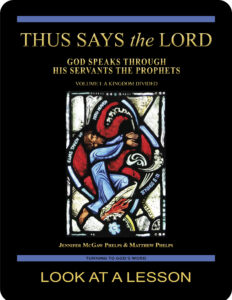
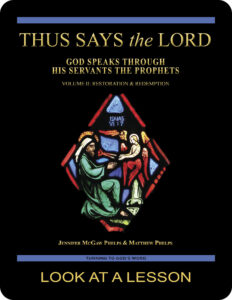 Thus Says the LORD: God Speaks Through His Servants the Prophets—Volume I: A Kingdom Divided examines the prophets in their historical context using the First and Second Books of the Kings and other Old Testament passages written before the Babylonian Exile in 586 B.C. Volume II: Restoration & Redemption looks at the post-exilic prophets. This 51-lesson Catholic Bible study builds on The United Kingdom of Israel: Saul, David & Solomon Foreshadow Christ the King. Click on the books’ covers to view a sample lesson from each volume.
Thus Says the LORD: God Speaks Through His Servants the Prophets—Volume I: A Kingdom Divided examines the prophets in their historical context using the First and Second Books of the Kings and other Old Testament passages written before the Babylonian Exile in 586 B.C. Volume II: Restoration & Redemption looks at the post-exilic prophets. This 51-lesson Catholic Bible study builds on The United Kingdom of Israel: Saul, David & Solomon Foreshadow Christ the King. Click on the books’ covers to view a sample lesson from each volume.
start a Turning to God’s Word Bible study
 Thank you for your interest in The Revelation of Jesus Christ: The Faithful Witness.
Thank you for your interest in The Revelation of Jesus Christ: The Faithful Witness.  Information about beginning a Turning to God’s Word Bible study can be found at start a Bible study. Tami, Matthew, and I are available to answer questions and offer support. Contact us if you’d like to start one of our studies or have your schedule listed with other TtGW study groups on our website. —Jennifer
Information about beginning a Turning to God’s Word Bible study can be found at start a Bible study. Tami, Matthew, and I are available to answer questions and offer support. Contact us if you’d like to start one of our studies or have your schedule listed with other TtGW study groups on our website. —Jennifer
*There are seven deuterocanonical books in the Old Testament—the Books of Tobit, Judith, Wisdom, Sirach, Baruch, and First and Second Maccabees, as well as some passages in the Books of Esther and Daniel. Protestants usually refer to these works as “apocryphal,” a word that means “outside the (Protestant) canon” because they’re excluded from most Protestant Bibles. The word “deuterocanonical” means “second canon”; Catholics use that word to refer to any section of the Catholic Old Testament for which there are no extant, or existing, Hebrew manuscripts. All of the deuterocanonical books appear in the Septuagint, the earliest remaining versions of which date to the 1st century B.C. This Greek translation of the Old Testament was in common use by Jews at the time of Jesus. Learn more by reading How Do Catholic & Protestant Bibles Differ?
Turning to God’s Word printed Bible studies use the 2006 Revised Standard Version Second Catholic Edition (RSV2CE) translation for all Scripture references except those to the Psalms, which are taken from The Abbey Psalms and Canticles, prepared by the Benedictine monks of Conception Abbey and published in 2020 by the United States Conference of Catholic Bishops (USCCB). All Scripture links for the online pages of The Revelation of Jesus Christ: The Faithful Witness are to the 1966 Revised Standard Version Catholic Edition (RSVCE) translation. The New International Version (NIV) audio recordings follow the same chapter and verse numbering as the RSV Catholic translations, but the NIV translation doesn’t include the deuterocanonical books and passages.
The 1966 RSVCE uses archaic pronouns and verb forms such as “thee,” “thou,” “didst” in the Psalms and in direct quotations attributed to God. The 2006 RSV2CE replaces these with more accessible English. The few significant translation changes in the RSV2CE include rendering almah as “virgin” in the Book of Isaiah 7:14 and restoring the term “begotten” in the Gospel According to John 3:16.
Numbering varies for some passages in this Bible study. Turning to God’s Word studies (print and digital) follow the numbering in the Revised Standard Version Catholic translations (RSV2CE and RSVCE). Discrepancies in the New American Bible Revised Edition (NABRE) are noted in the Index of Scripture Citations in the study book and the online sample.
 You can learn more about the Psalms by viewing a sample lesson from the Turning to God’s Word Catholic Bible study Sing a New Psalm: Communicating with God Through the Prayers of the Church—Volume I: Lauds & Vespers. The second part of that study, Sing a New Psalm: Communicating with God Through the Prayers of the Church—Volume II: Vigils, Day Prayer & Compline, is scheduled for publication in 2025. Some verse numbers may vary in different translations of the Psalms.
You can learn more about the Psalms by viewing a sample lesson from the Turning to God’s Word Catholic Bible study Sing a New Psalm: Communicating with God Through the Prayers of the Church—Volume I: Lauds & Vespers. The second part of that study, Sing a New Psalm: Communicating with God Through the Prayers of the Church—Volume II: Vigils, Day Prayer & Compline, is scheduled for publication in 2025. Some verse numbers may vary in different translations of the Psalms.
